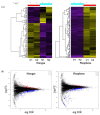Nutrient Deficiencies Impact on the Cellular and Metabolic Responses of Saxitoxin Producing Alexandrium minutum: A Transcriptomic Perspective
- PMID: 37755110
- PMCID: PMC10532982
- DOI: 10.3390/md21090497
Nutrient Deficiencies Impact on the Cellular and Metabolic Responses of Saxitoxin Producing Alexandrium minutum: A Transcriptomic Perspective
Abstract
Dinoflagellate Alexandrium minutum Halim is commonly associated with harmful algal blooms (HABs) in tropical marine waters due to its saxitoxin production. However, limited information is available regarding the cellular and metabolic changes of A. minutum in nutrient-deficient environments. To fill this gap, our study aimed to investigate the transcriptomic responses of A. minutum under nitrogen and phosphorus deficiency. The induction of nitrogen and phosphorus deficiency resulted in the identification of 1049 and 763 differently expressed genes (DEGs), respectively. Further analysis using gene set enrichment analysis (GSEA) revealed 702 and 1251 enriched gene ontology (GO) terms associated with nitrogen and phosphorus deficiency, respectively. Our results indicate that in laboratory cultures, nitrogen deficiency primarily affects meiosis, carbohydrate catabolism, ammonium assimilation, ion homeostasis, and protein kinase activity. On the other hand, phosphorus deficiency primarily affects the carbon metabolic response, cellular ion transfer, actin-dependent cell movement, signalling pathways, and protein recycling. Our study provides valuable insights into biological processes and genes regulating A. minutum's response to nutrient deficiencies, furthering our understanding of the ecophysiological response of HABs to environmental change.
Keywords: gene set enrichment analysis; harmful algae blooms; saxitoxin; transcriptomics.
Conflict of interest statement
The authors declare no conflict of interest.
Figures







Similar articles
-
Insights into Alexandrium minutum Nutrient Acquisition, Metabolism and Saxitoxin Biosynthesis through Comprehensive Transcriptome Survey.Biology (Basel). 2021 Aug 25;10(9):826. doi: 10.3390/biology10090826. Biology (Basel). 2021. PMID: 34571703 Free PMC article.
-
Physiological and transcriptional responses to inorganic nutrition in a tropical Pacific strain of Alexandrium minutum: Implications for the saxitoxin genes and toxin production.Harmful Algae. 2016 Jun;56:9-21. doi: 10.1016/j.hal.2016.04.005. Epub 2016 May 17. Harmful Algae. 2016. PMID: 28073499
-
Environmental Factors Modulate Saxitoxins (STXs) Production in Toxic Dinoflagellate Alexandrium: An Updated Review of STXs and Synthesis Gene Aspects.Toxins (Basel). 2024 Apr 30;16(5):210. doi: 10.3390/toxins16050210. Toxins (Basel). 2024. PMID: 38787062 Free PMC article. Review.
-
SxtA and sxtG gene expression and toxin production in the Mediterranean Alexandrium minutum (Dinophyceae).Mar Drugs. 2014 Oct 22;12(10):5258-76. doi: 10.3390/md12105258. Mar Drugs. 2014. PMID: 25341029 Free PMC article.
-
Biosynthesis of Saxitoxin in Marine Dinoflagellates: An Omics Perspective.Mar Drugs. 2020 Feb 5;18(2):103. doi: 10.3390/md18020103. Mar Drugs. 2020. PMID: 32033403 Free PMC article. Review.
Cited by
-
Saxitoxin: A Comprehensive Review of Its History, Structure, Toxicology, Biosynthesis, Detection, and Preventive Implications.Mar Drugs. 2025 Jul 2;23(7):277. doi: 10.3390/md23070277. Mar Drugs. 2025. PMID: 40710502 Free PMC article. Review.
-
Transcriptomic Analysis of Cold-Induced Temporary Cysts in Marine Dinoflagellate Prorocentrum cordatum.Int J Mol Sci. 2025 Jun 6;26(12):5432. doi: 10.3390/ijms26125432. Int J Mol Sci. 2025. PMID: 40564896 Free PMC article.
References
-
- Mohd-Din M., Hii K.S., Abdul-Wahab M.F., Mohamad S.E., Gu H., Leaw C.P., Lim P.T. Spatial-temporal variability of microphytoplankton assemblages including harmful microalgae in a tropical semi-enclosed strait (Johor Strait, Malaysia) Mar. Environ. Res. 2022;175:105589. doi: 10.1016/j.marenvres.2022.105589. - DOI - PubMed
-
- Chai X., Li X., Hii K.S., Zhang Q., Deng Q., Wan L., Zheng L., Lim P.T., Tan S.N., Mohd-Din M., et al. Blooms of diatom and dinoflagellate associated with nutrient imbalance driven by cycling of nitrogen and phosphorus in anaerobic sediments in Johor Strait (Malaysia) Mar. Environ. Res. 2021;169:105398. doi: 10.1016/j.marenvres.2021.105398. - DOI - PubMed
MeSH terms
Substances
Grants and funding
LinkOut - more resources
Full Text Sources
Miscellaneous

